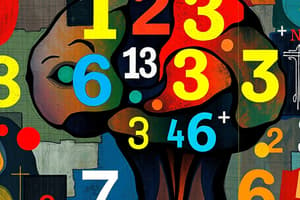Podcast
Questions and Answers
Our prehistoric ancestors would have had a general sensibility about ______, and would have instinctively known the difference between one and two antelopes.
Our prehistoric ancestors would have had a general sensibility about ______, and would have instinctively known the difference between one and two antelopes.
amounts
The intellectual leap from the concrete idea of two things to the invention of a symbol or word for the abstract idea of ______ took many ages to come about.
The intellectual leap from the concrete idea of two things to the invention of a symbol or word for the abstract idea of ______ took many ages to come about.
two
Even today, there are isolated hunter gatherer tribes in Amazonia which only have words for 'one', 'two' and ______.
Even today, there are isolated hunter gatherer tribes in Amazonia which only have words for 'one', 'two' and ______.
many
In the absence of settled agriculture and ______, there is little need for a formal system of numbers.
In the absence of settled agriculture and ______, there is little need for a formal system of numbers.
Some of the very earliest evidence of mankind thinking about numbers is from notched bones in Africa dating back to ______ to 20,000 years ago.
Some of the very earliest evidence of mankind thinking about numbers is from notched bones in Africa dating back to ______ to 20,000 years ago.
Mathematics proper initially developed largely as a response to bureaucratic needs when civilizations settled and developed ______.
Mathematics proper initially developed largely as a response to bureaucratic needs when civilizations settled and developed ______.
Evidence of basic arithmetic and geometric notations on the petroglyphs at Knowth and Newgrange burial mounds in ______ has been found.
Evidence of basic arithmetic and geometric notations on the petroglyphs at Knowth and Newgrange burial mounds in ______ has been found.
This system of counting, utilizing a repeated zig-zag ______, continued to be used in Britain and Ireland into the 1st millennium BCE.
This system of counting, utilizing a repeated zig-zag ______, continued to be used in Britain and Ireland into the 1st millennium BCE.
Flashcards are hidden until you start studying
Study Notes
Early Numerical Awareness
- Prehistoric ancestors instinctively distinguished between quantities, knowing the difference between one and two antelopes.
- Transition from concrete counting to abstract numerical concepts, like the word "two," took a significant amount of time.
Language and Numbers Among Hunter-Gatherers
- Isolated Amazonian tribes have limited vocabulary for numbers, often only having terms for "one," "two," and "many."
- Some tribes only count up to five, reflecting minimal need for formal numerical systems due to lack of settled agriculture or trade.
Early Evidence of Counting
- Notched bones found in Africa, dating back 35,000 to 20,000 years, indicate early counting methods rather than formal mathematics.
- Markings represent basic tallying rather than advanced numerical concepts.
Geometric Representations
- Pre-dynastic Egyptians and Sumerians showcased geometric designs on artefacts during the 5th millennium BCE.
- Some megalithic societies in northern Europe also represented patterns and designs from the 3rd millennium BCE, primarily for art rather than systematic mathematics.
Rise of Mathematics with Civilization
- Mathematics developed primarily due to bureaucratic needs as civilizations established agriculture, particularly in Sumerian, Babylonian, and ancient Egyptian contexts.
- Requirements included land measurement and taxation, leading to more formal methods of calculation.
Evidence of Early Mathematical Practices
- Petroglyphs from Knowth and Newgrange burial mounds in Ireland (circa 3500 BCE and 3200 BCE) display basic arithmetic and geometric notations.
- Zig-zag glyphs used for counting influenced numerical systems in Britain and Ireland into the 1st millennium BCE.
Ancient Astronomical Practices
- Stonehenge, a Neolithic site from around 2300 BCE, demonstrates early understanding of measurements through its use of the numbers 60 and 360, likely developed independently from Sumerian sexagesimal systems.
Studying That Suits You
Use AI to generate personalized quizzes and flashcards to suit your learning preferences.




